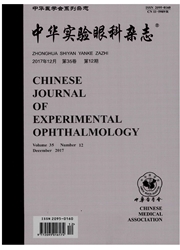

 中文摘要:
中文摘要:
背景本课题组前期已筛选得到了靶向转化生长因子-β(TGF-β)Ⅱ型受体(TpRⅡ)的核酸适配子S58,并证明S58可抑制TGF-β介导的人Tenon囊成纤维细胞(HTFs)转分化作用。壳聚糖纳米微粒( CS-NP)已被证实可作为药物载体,但其包埋S58后抑制HTFs增生的有效性和安全性值得关注。目的制备CS(S58)-NP,研究其生物学特性,并观察CS~NP对S58的保护及缓释作用。方法本研究所用细胞由本课题组前期原代培养的HTFs传代而来,取第4-10代对数生长期的细胞用于实验。以S58为实验对象,通过离子交联法制备出不同浓度CS-NP与S58表面电荷比(N/P比)的CS(S58)-NP。应用Zeta粒径分析仪检测CS(S58)-NP粒径及其Zeta电位;用扫描电子显微镜观察粒径的大小、形态及分布情况;采用琼脂糖凝胶电泳法检测CS-NP与S58的结合情况,并评估CS(S58)-NP对核酸酶的抵抗能力;用紫外分光光度计检测不同时间点缓释液PBS中S58的含量,以判断CS(S58)-NP缓释S58的情况;利用乳酸脱氢酶(LDH)释放实验检测CS(S58)-NP对HTFs的细胞毒性。结果制备的CS(S58)-NP粒径分布于130~270nnl之间,其Zeta电位分布范围为+16-+28mV;扫描电子显微镜下可观察到CS(S58)-NP呈球形,分布均匀,粒径在300nm以内。当CS-NP与S58N/P比例为10、20、30、40时,CS(S58).NP平均包封率分别为88.9%、89.3%、91.7%、90.5%;加入DNaseI组与无DNaseI组比较,S58经CS-NP包裹后能够明显抵御DNaseI的酶解作用;体外缓释实验发现,CS-NP在PBS中持续缓慢释放S58,随着时间的延长,S58累计释放量增加,以24~36h释放速率最高,96hS58累计释放量为100%。随着CS(S58)-NP浓度的增加,HTFs上清液中LDH相对释放率逐渐增加,差异有统计学意义(F=588.018,P=0.000)。50nmol/LCS(S58)-NP处理HTFs48h时LDH相对释放率最大,为(12.853±
 英文摘要:
英文摘要:
Background Our previous study demonstrated that the aptamer S58 specifically targeted transforming growth factor-J3 receptor II (TβRII) and inhibited the transdifferentiation of human Tenon capsule fibroblasts (HTFs) mediated by transforming growth factor-β (TGF-β). Chitosan-nanoparticles (CS-NP) are good drug carriers,hut the efficacy and safety of CS-NP/aptamer complexes deserve attention. Objective The aim of this study was to synthesize a novel CS-NP/aptamer complex called CS (S58)-NP and investigate its properties and applicability. Methods Human Tenon capsule tissue was obtained from patients during strabismus surgery, and HTFs were cultured and passaged using the explant culture method. The fourth to tenth generations of ceils were used in the experiment. Different concentrations of CS-NP were used to prepare the CS(S58)-NP by the ionic cross-linkingmethod with a surface charge rate (N/P) for S58 of 10,20,30 or 40. The particle size and Zeta potential were measured by the Zeta analyzer. The shape and distribution of CS ( S58 )-NP particles were examined under the scanning electron microscope. The binding of CS-NP with S58 and resistance of CS ( S58 )-NP to DNase I were examined by agarose gel eletrophoresis. The release rate of S58 from CS ( S58 ) -NP in PBS was quantitatively analyzed by a ultraviolet spectrophotometer. The cytotoxicity of CS( S58 ) -NP to HTFs was evaluated by detecting the production of lactate dehydrogenase (LDH). Results The Zeta analyzer showed that the particle size of CS (S58) -NP was 130-270 nm and its electric potential ranged from + 16 to +28 mV. The CS (S58)-NP particles appeared spherical with an even distribution under the scanning electron microscope. The mean encapsulation efficiency of CS( S58 )-NP was 88.9% ,89.3 % ,91.7% or 90.5 % , respectively, when the N/P was 10,20,30 or 40. After being encapsuled by CS-NP,S58 could resist the degradation from DNase I. Its total releasing level in PBS increased with t
 同期刊论文项目
同期刊论文项目
 同项目期刊论文
同项目期刊论文
 期刊信息
期刊信息
